Tips for flower growers: how to properly care for and transplant an orchid
Beauties orchids known to mankind for four million years. Appearing in Japanese and Chinese countries, they were used to make medicines. In European countries, orchids began to be cultivated two hundred thousand years ago, and today there are about 30 thousand varieties of these plants.
Thanks to the long and hard work of scientists, it has now become possible to plant orchids at home. However, it should be borne in mind that this plant is very capricious and will not tolerate negligence.
Content:
- Types and varieties of orchids for home breeding
- How to create the right conditions for a capricious beauty
- Providing proper flower care
- Transplanting and pruning an orchid
- Orchid care during flowering
- What and who can threaten orchids
Types and varieties of orchids for home breeding
Variety and availability of species orchids for growing in apartments and houses allows everyone to choose the plant that suits him best. Orchid bloom lasts several months and several different species can provide year-round blooming of the winter garden:
- Brassia verrucosa. This species is also called the Spider Orchid because its strings and sepals are like cute little spiders. The flowers have a poor greenish color and reach a diameter of 10 cm. Brassia blooms from the end of spring, after which she needs peace, which is achieved by reducing watering until the beginning of the next stage of growth. The spider orchid is the most picky of all orchids.
- Cambria (Cambriya). It is a hybrid of three orchid species that does not occur in the wild. It forms inflorescences of various shapes and sizes, and high peduncles require support. It grows best on a windowsill, however, in summer it needs shading from direct sunlight. In winter, it is necessary to provide additional lighting at night and maintain the temperature at least 13 degrees. The soil must be constantly moist. In winter watering reduce, but do not exclude.
- Cattleya. It features a spectacular waxy flower with a bright, prominent lip with wavy edges. The flowers come in a variety of shades of purple, pink, crimson and yellow. Period flowering begins in spring and lasts until autumn. The life span of each flower is about three weeks. After Cattleya sheds the last bud, she needs to be allowed to rest for at least two months, reducing watering. The plant must be placed in a sufficiently lit place with morning or evening sun. Periodically, you should wipe the leaves with a sponge soaked in non-cold water.
- Cymbidium (Cymdidium). This is a fairly large type of orchid that grows well on the windowsill and is quite resistant to adverse factors. Cymbidium is believed to have soothing properties.Today, miniature Cymbidiums are more popular, which produce vertical peduncles strewn with flowers. Flowering occurs in the autumn-winter period and lasts from two to three months. Cymbidium prefers well-lit places where the sun comes in in the morning or evening. In summer, it is advisable to take the flower outside and place it in partial shade, and in winter place it in a room where the temperature will be at least 10 degrees.
- Phalaenopsis (Falenopsis). Differs in elegant complex flowers on long peduncles. Flowering continues for several months. The flower is a fairly budget option, therefore it is available to many. A suitable temperature for the content is considered to be 18-30 degrees. Watering is needed moderate, which is carried out after the soil has completely dried out.
How to create the right conditions for a capricious beauty
Facing cultivation for the first time orchids, many are afraid of the complexity of caring for this beautiful flower. However, after understanding the nuances, things do not look so scary. You just need to choose the right place for the new pet with good lighting, ensure timely hydration and transplantation. In gratitude, a green friend will delight you with chic and unusual flowers for more than one month.
When buying orchids, you should pay attention to the condition of the substrate and roots.
If there are dried roots, then they should be removed immediately or another copy should be chosen, which will have a healthy and strong appearance. When the orchid is brought into the house, it needs to be provided such conditions that it can calmly endure the stress of the move. The ideal solution would be to establish a quarantine for the orchid, that is, placing the beauty separately from other green inhabitants.
The plant should not be placed in direct sunlight; during the adaptation period, the orchid needs rest. Also, at first, it should not be fed and watered. But it is necessary to observe the state of leaves and shoots in order to identify signs in time pests and diseases... After quarantine conditions, the flower must be gradually adapted to the sun and moderate watering should be started.
Providing proper lighting is an important point in the care of an orchid, which is responsible for flower production:
- an abundance of diffused light. Avoid direct sunlight
- in the summer, the flower should be shaded
- ensure the duration of daylight hours at least 10 hours, 12 hours would be ideal. For this, fluorescent lamps are used.
- after wintering, the orchid needs to adapt to the sun's rays, and during flowering, the plant should be moved to the shade. Otherwise, the orchid will quickly shed its buds.
The establishment of the temperature regime directly depends on the selected orchid variety, because all types are divided into several subgroups:
- Heat-loving, these include Phalaenopsis, prefer temperatures from 15 to 30 degrees and will not put up with even minor differences.
- Lovers of medium temperatures, such as miltonia. They develop well at moderate temperatures, which should not be higher than 22-23 degrees.
- Fans of colder climates. Notable representatives are Lellia and Australian Dendrobium. A suitable temperature for these colors is 18 degrees.
It is very difficult to establish natural humidity in an apartment for orchids. Therefore, for amateur flower growers who do not have experience in growing orchids, a simple spraying with a spray bottle is recommended, however, the water should not affect the peduncles or the placement of a bowl of water near a capricious beauty. It is also possible to use humidifiers. Additionally, you can pamper the plant with a warm shower, while you need to ensure that the water pressure is not strong.
Providing proper flower care
To provide the green pet with optimal living conditions, certain conditions must be observed:
- Correct watering... It should be remembered that orchids do not like waterlogging and stagnant water, but they tolerate underfilling calmly. Plants should be watered about once a week, only after the soil in the flowerpot has dried. An indicator of a lack or excess of moisture is the leaves, which wrinkle if there is little water and turn yellow, if water stagnation has formed and the decay process has begun root system... Standing rain or melt water is best suited for irrigating orchids. You can also use purified (not boiled) tap water.
- Top dressing... The flower needs fertilization only at the time of growth and not too frequent, one or two times a month is enough. It is necessary to use special formulations for orchids after or during watering, in order to avoid burns to the root system. You never need to fertilize while the flower is resting and in winter. And if you carry out transplant plants with a complete replacement of the soil at least once every two years, then fertilizing can be omitted at all.
Transplanting and pruning an orchid
Transfer green pet is recommended every two years. Earlier than the term, orchids are transplanted in such cases:
- There is not enough room in the pot if there is a strong overgrowth of the plant.
- Many damaged roots.
- With spoiled soil or pot.
Before transplanting, you need to abundantly moisten the soil and very carefully remove the flower from the container, trying not to damage the fragile roots. Damaged roots must be removed with a sterile instrument, in this case with sharp scissors. The cut sites are disinfected with crushed activated carbon or ground cinnamon.
After such manipulations, the orchid is placed in an empty dry container and left for 5-6 days to dry the root system. After that, sphagnum moss is placed in the container so that it does not come into contact with the cut sites and is constantly moistened. Next, wait for the appearance of air roots. After that, the landing is carried out into the prepared soil.
Warmth and additional artificial lighting are essential.
Florists do not recommend buying a ready-made soil mixture, because it contains fluoride, which is able to retain moisture, which leads to rotting of the root system. It is better to prepare the soil mixture yourself. To do this, you need to take the bark from dry pines, cut into small pieces (up to 2 cm) and boil for an hour. You can add charcoal or some moss, but in this case additional fertilizers.
Pruning orchids are carried out after flowering. Peduncles are cut with sterile scissors completely to the base. However, if there are still resting buds, then partial pruning is carried out. The cut should be 1.5 cm above the buds and 7 mm from the root. The best time for pruning is the dormant period of the flower.
Orchid care during flowering
During the flowering period, the plant needs more moisture. It is recommended to irrigate with a warm (35 degrees) shower. However, the water should not get on the flowers.
After water procedures, it is imperative to remove water drops from growth points, otherwise decay will occur.
The night air temperature should be increased by 5-7 degrees. During this period, the plant spends a lot of energy and needs additional trace elements. Therefore, it is recommended to carry out top dressing.
It must be remembered that blooming orchids do not transplant, otherwise it will throw off all the buds. And it is not recommended to move the plant, then the flower will delight with flowering longer.
What and who can threaten orchids
There are several difficulties that can make growing orchids much more difficult:
- Orchid discards foliage and buds. There may be several reasons for this: lack of light or moisture. To eliminate this problem, it is enough to move the flower closer to the light source, humidify the air and eliminate the draft.The second reason may lie in the vicinity of ripe fruits, which are capable of emitting ethylene, which is harmful to the plant.
- Leaves are stained or the edges are wrinkled. The reason for this malaise may be the usual heat. Orchids love differences between night and day temperatures of about eight degrees.
- Lethargy of leaves is observed, and irrigation is regular. Probably, the plant is cramped in the pot and the root system is under pressure. Or watering is too abundant, but rare.
- The orchid does not release color. Either the flower needs rest, or temperature drops must be observed day and night.
- The leaves are covered with cones and black spots - these are burns that were left by direct sunlight. The plant needs daytime shading or diffused lighting.
- Leaves dry or rot - soft-bodied mites attacked the orchid.
- The leaves turn brown and on the inside are covered with a whitish sticky web - this is the result of being hit by spider mites.
- The flower has stopped growing, flowering is absent or very rare. This is how the plant reacts to settlements nematodes on the back of the sheet plate.
To combat harmful insects, plants are treated with soap solutions - with minor damage. If the settlements are extensive, then insecticidal agents should be used. It will be useful to replace the soil and disinfection landing capacity.
Although caring for beautiful orchids will require considerable effort, the result will be a beautiful and long flowering that will not only complement any interior, but also fill the room with the aroma of apples, chocolate or watermelon. In addition, orchids can have a calming effect on household members, resulting in a relaxed, relaxed atmosphere in the home.
More information can be found in the video:





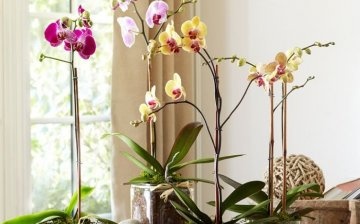
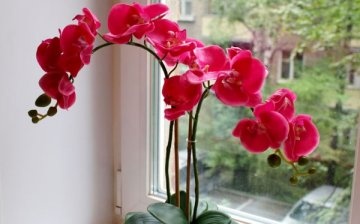
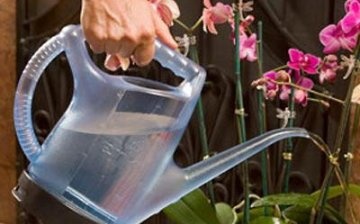
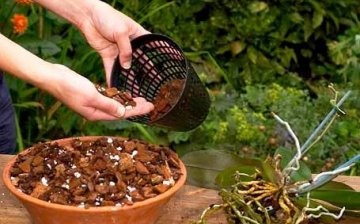

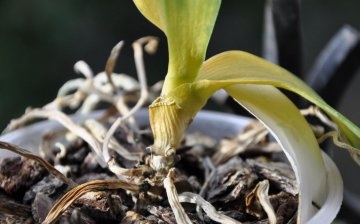








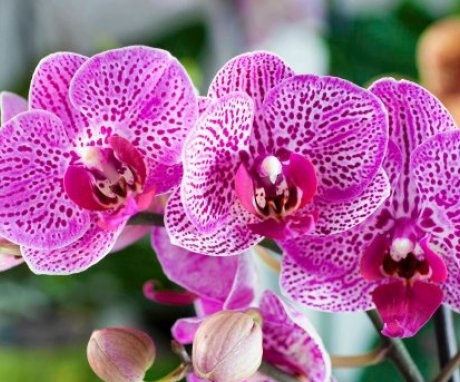


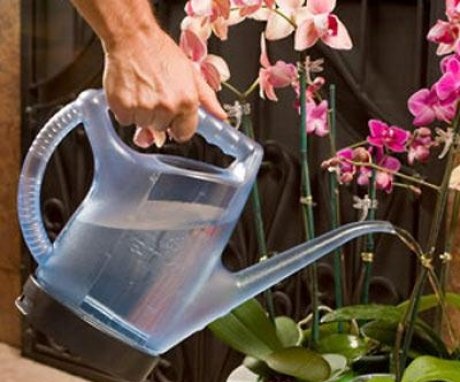
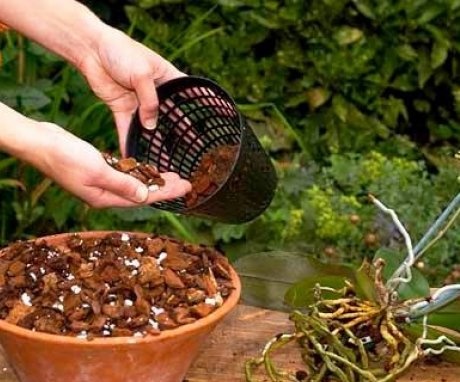
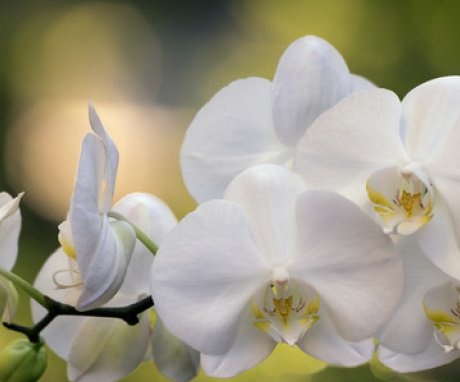
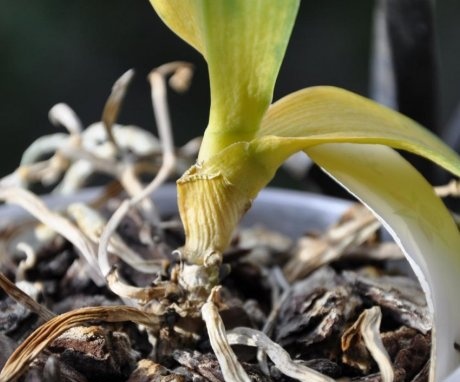
We have a phalaenopsis orchid at home. It grows in a pot filled with tree bark with holes in the walls. We water the flower quite rarely, because the orchid should have no more than four leaves below, if there are more of them, then this indicates an excess of moisture.